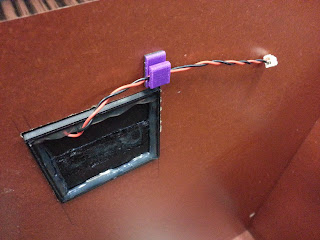 |
| Servo bracket Before modification |
 |
| Servo bracket After modification |
 |
| Servo bracket screwed on to the side of the Drawer beside the lock |
The servo bracket was also placed just nice so there will be no obstruction when the arm axle turn.
 |
| Servo bracket Before modification |
 |
| Servo bracket After modification |
 |
| Servo bracket screwed on to the side of the Drawer beside the lock |
 |
| Wire clips |
 |
| Image of Battery Holder firmly glue on to the Drawer |
 |
| Before the battery has been pull out |
 |
| Last battery remaining before pulling out just by easily pulling the ribbon |
 |
| Before the Process |
 |
| 2 of the component is glue together using insta-flex+- |
 |
| After the glue has dry up , the battery cover will be place in the middle and glued up |
 |
| Battery Holder with Battery and Cover nicely glue onto the Drawer |
 |
| End Product (After Modification) |
 |
| End Product (Before Modification) |